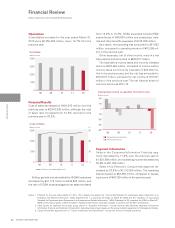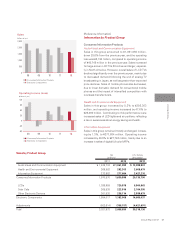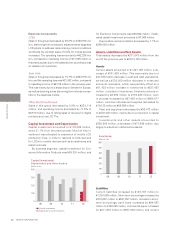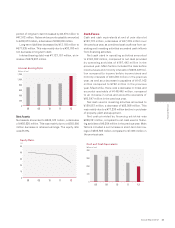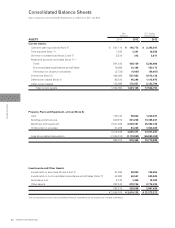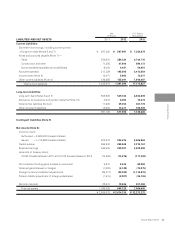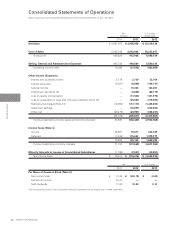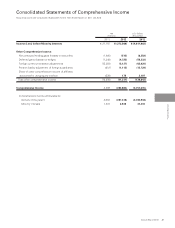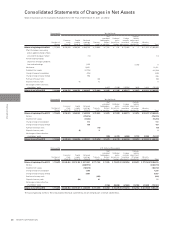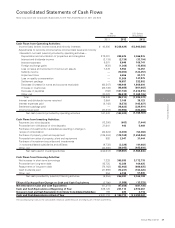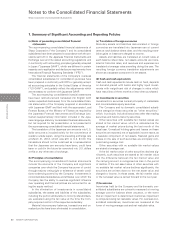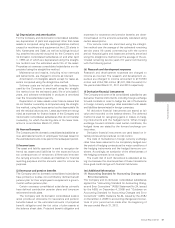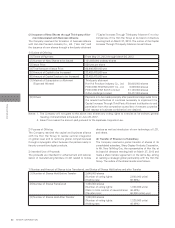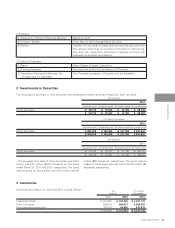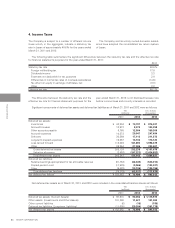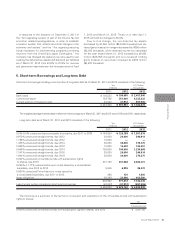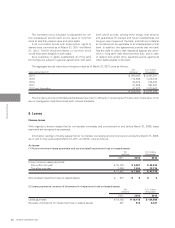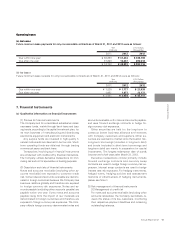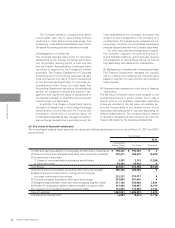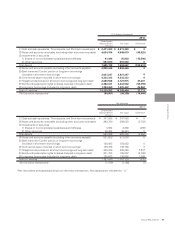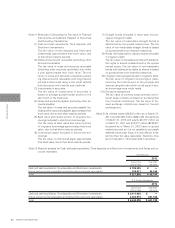Sharp 2012 Annual Report Download - page 52
Download and view the complete annual report
Please find page 52 of the 2012 Sharp annual report below. You can navigate through the pages in the report by either clicking on the pages listed below, or by using the keyword search tool below to find specific information within the annual report.
50 SHARP CORPORATION
Financial Section
Notes to the Consolidated Financial Statements
Sharp Corporation and Consolidated Subsidiaries
1. Summary of Significant Accounting and Reporting Policies
(a) Basis of presenting consolidated financial
statements
The accompanying consolidated financial statements of
Sharp Corporation (“the Company”) and its consolidated
subsidiaries have been prepared in accordance with the pro-
visions set forth in the Japanese Financial Instruments and
Exchange Law and its related accounting regulations and
in conformity with accounting principles generally accepted
in Japan (“Japanese GAAP”), which are different in certain
respects as to application and disclosure requirements from
International Financial Reporting Standards (“IFRS”).
The financial statements of the Company’s overseas
consolidated subsidiaries for consolidation purposes have
been prepared in conformity with IFRS or generally accept-
ed accounting principles in the United States of America
(“US GAAP”), and partially reflect the adjustments which
are necessary to conform with Japanese GAAP.
The accompanying consolidated financial statements
have been restructured and translated into English (with
certain expanded disclosures) from the consolidated finan-
cial statements of the Company prepared in accordance
with Japanese GAAP and filed with the appropriate Local
Finance Bureau of the Ministry of Finance as required by
the Japanese Financial Instruments and Exchange Law.
Certain supplementary information included in the Japa-
nese language statutory consolidated financial statements,
but not required for fair presentation, is not presented in
the accompanying consolidated financial statements.
The translation of the Japanese yen amounts into U.S.
dollar amounts is included solely for the convenience of
readers outside Japan, using the prevailing exchange rate
at March 31, 2012, which was ¥81 to U.S. $1.00. The
translations should not be construed as a representation
that the Japanese yen amounts have been, could have
been or could in the future be converted into U.S. dollars
at this or any other rate of exchange.
(b) Principles of consolidation
The accompanying consolidated financial statements
include the accounts of the Company and significant
companies over which the Company has power of control
through majority voting right or existence of certain condi-
tions evidencing control by the Company. Investments in
nonconsolidated subsidiaries and affiliates over which the
Company has the ability to exercise significant influence
over operating and financial policies are accounted for us-
ing the equity method.
In the elimination of investments in consolidated
subsidiaries, the assets and liabilities of the subsidiaries,
including the portion attributable to minority shareholders,
are evaluated using the fair value at the time the Com-
pany acquired control of the respective subsidiary.
Material intercompany balances, transactions and un-
realized profits have been eliminated in consolidation.
(c) Translation of foreign currencies
Monetary assets and liabilities denominated in foreign
currencies are translated into Japanese yen at current
rates at each balance sheet date, and the resulting trans-
lation gains or losses are charged to income.
Assets and liabilities are translated at current rates at
each balance sheet date, net assets accounts are trans-
lated at historical rates, and revenues and expenses are
translated at average rates prevailing during the year. The
resulting foreign currency translation adjustments are
shown as a separate component in net assets.
(d) Cash and cash equivalents
Cash and cash equivalents include cash on hand, deposits
on demand placed with banks and highly liquid invest-
ments with insignificant risk of changes in value which
have maturities of three months or less when purchased.
(e) Investments in securities
Investments in securities consist principally of marketable
and nonmarketable equity securities.
The Company and its domestic consolidated subsid-
iaries categorize those securities as “other securities,”
which, in principle, include all securities other than trading
securities and held-to-maturity securities.
Other securities with available fair market values are
stated at fair market value, which is calculated as the
average of market prices during the last month of the
fiscal year. Unrealized holding gains and losses on these
securities are reported, net of applicable income taxes, as
a separate component of net assets. Realized gains and
losses on the sale of such securities are principally com-
puted using average cost.
Other securities with no available fair market values
are stated at average cost.
If the fair market value of other securities declines sig-
nificantly, such securities are stated at fair market value
and the difference between the fair market value and
the carrying amount is recognized as loss in the period
of decline. If the net asset value of other securities with
no available fair market values declines significantly, the
securities are written down to the net asset value and
charged to income. In these cases, the fair market value
or the net asset value is carried forward to the next year.
(f) Inventories
Inventories held by the Company and its domestic con-
solidated subsidiaries are primarily measured at moving
average cost (for balance sheet valuation, in the event
that an impairment is determined inventories impairment
is computed using net realizable value). For overseas con-
solidated subsidiaries, inventories are measured at the
lower of moving average cost and net realizable value.


